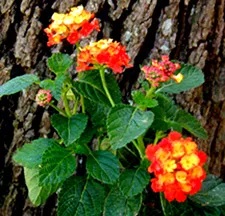NICE! Plant of the Month
(Lantana urticoides (L. horrida))

Family: Verbenaceae (Verbena family)
Other Common Names: Calico bush, Hierba de Cristo
Type: Perennial shrub, usually freezes back in winter
Natural Habitat: Southwestern U.S. and northern Mexico
Growth: Low spreading multi-branched shrub, 3-6’ tall, 4-5’ wide; stems rough with small prickles
Deer Resistance: Deer generally do not browse
Wildlife: Flowers very attractive to butterflies and hummingbirds; birds eat fruit
Light Tolerance: Full to part sun; blooms best in full sun
Flowers: Spring to fall; numerous brightly colored, 1-2” rounded heads of small yellow and orange tubular flowers, maturing to deep orange or red.
Fruit: Tight clusters of small, round, fleshy blue to black fruits; poisonous
Leaves: Opposite, deciduous, ovate with pointed tips and toothed margins, 1-3” long; surface very rough; strongly aromatic, sometimes considered to be unpleasant
Water Requirements: Very low once established. Very drought and heat tolerant.
Soil Requirements: Well-drained sand, loam, clay, caliche
Planting Instructions: Space plants 4-5 feet apart, or closer for mass planting. Dig a hole at least two times wider than, but the same depth as the root ball in the nursery container. Sides of the hole should be irregular, not smooth. Remove plant from container, taking care to support the root ball. Loosen exterior roots gently with your fingers. If the plant is root-bound and cannot be loosened by hand, the outer roots may be cut in several places. Lift the plant by the root ball and place into the hole. Backfill hole, using soil that was dug out. Do not add any soil to the top of the root ball. Gently firm the soil with your hands, but do not tamp it down. Place 3-4 inches of mulch over the bare soil around, but not touching the base of the plant.
Watering Instructions: Water deeply after planting to settle soil around roots. Then every 7-10 days, as needed, during the first growing season. Before watering, check for soil moisture at a depth of an inch or two at the edge of the root ball. Skip a watering after a rainfall of ½ to 1 inch. Maintain this watering schedule until the first fall. Reduce watering during the cool fall and winter months. In a “normal” year, no watering may be necessary during the fall and winter, but during a dry period, monthly watering may be needed. Second spring and thereafter: Water monthly only during periods of drought. Once established, natives will survive with little supplemental irrigation.
NICE! Tip: Cut back almost to the ground in winter/early spring; prune in mid-summer to promote flowering on new growth. Cultivars and hybrids offer a variety of growth habits and flower colors, and many are continuous bloomers which don’t produce berries. Avoid the pink and yellow L. camara, and trailing white or lavender L. montevidensis, which can become invasive.
Look for the NICE! Plant of the Month signs and information sheets on your next visit to a participating Boerne nursery. And thank you for supporting native plants by using them in your landscapes.


